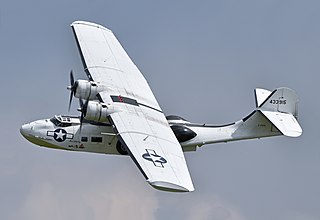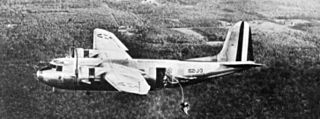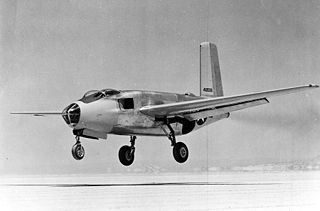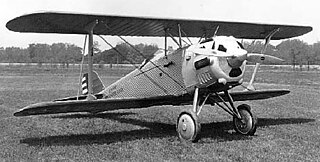Related Research Articles

The McDonnell FH Phantom was a twinjet fighter aircraft designed and first flown during World War II for the United States Navy. The Phantom was the first purely jet-powered aircraft to land on an American aircraft carrier and the first jet deployed by the United States Marine Corps. Although with the end of the war, only 62 FH-1s were built, it helped prove the viability of carrier-based jet fighters. As McDonnell's first successful fighter, leading to the development of the follow-on F2H Banshee, which was one of the two most important naval jet fighters of the Korean War, it would also establish McDonnell as an important supplier of navy aircraft. When McDonnell chose to bring the name back with the Mach 2–class McDonnell Douglas F-4 Phantom II, it launched what would become the most versatile and widely used western combat aircraft of the Vietnam War era, adopted by the USAF and the US Navy, remaining in use with various countries to the present day.

The Douglas DC-3 is a propeller-driven airliner, which had a lasting effect on the airline industry in the 1930s to 1940s and World War II. It was developed as a larger, improved 14-bed sleeper version of the Douglas DC-2. It is a low-wing metal monoplane with conventional landing gear, powered by two radial piston engines of 1,000–1,200 hp (750–890 kW). The DC-3 has a cruising speed of 207 mph (333 km/h), a capacity of 21 to 32 passengers or 6,000 lbs (2,700 kg) of cargo, and a range of 1,500 mi (2,400 km), and can operate from short runways.

The Douglas Aircraft Company was an American aerospace manufacturer based in Southern California. It was founded in 1921 by Donald Wills Douglas Sr. and later merged with McDonnell Aircraft in 1967 to form McDonnell Douglas; it then operated as a division of McDonnell Douglas. McDonnell Douglas later merged with Boeing in 1997.

The Consolidated PBY Catalina is a flying boat and amphibious aircraft that was produced in the 1930s and 1940s. In Canadian service it was known as the Canso. It was one of the most widely used seaplanes of World War II. Catalinas served with every branch of the United States Armed Forces and in the air forces and navies of many other nations. The last military PBYs served until the 1980s. As of 2021, 86 years after its first flight, the aircraft continues to fly as a waterbomber in aerial firefighting operations in some parts of the world. None remain in military service.
The McDonnell Aircraft Corporation was an American aerospace manufacturer based in St. Louis, Missouri. The company was founded on July 6, 1939, by James Smith McDonnell, and was best known for its military fighters, including the F-4 Phantom II, and manned spacecraft including the Mercury capsule and Gemini capsule. McDonnell Aircraft later merged with the Douglas Aircraft Company to form McDonnell Douglas in 1967.

The Douglas C-54 Skymaster is a four-engined transport aircraft used by the United States Army Air Forces in World War II and the Korean War. Like the Douglas C-47 Skytrain derived from the DC-3, the C-54 Skymaster was derived from a civilian airliner, the Douglas DC-4. Besides transport of cargo, the C-54 also carried presidents, prime ministers, and military staff. Dozens of variants of the C-54 were employed in a wide variety of non-combat roles such as air-sea rescue, scientific and military research, and missile tracking and recovery. During the Berlin Airlift it hauled coal and food supplies to West Berlin. After the Korean War it continued to be used for military and civilian uses by more than 30 countries. It was one of the first aircraft to carry the President of the United States, the first being President Franklin D. Roosevelt during World War II.

The Douglas DC-6 is a piston-powered airliner and cargo aircraft built by the Douglas Aircraft Company from 1946 to 1958. Originally intended as a military transport near the end of World War II, it was reworked after the war to compete with the Lockheed Constellation in the long-range commercial transport market. More than 700 were built and many still fly today in cargo, military, and wildfire control roles.

The Douglas SBD Dauntless is a World War II American naval scout plane and dive bomber that was manufactured by Douglas Aircraft from 1940 through 1944. The SBD was the United States Navy's main carrier-based scout/dive bomber from mid-1940 through mid-1944. The SBD was also flown by the United States Marine Corps, both from land air bases and aircraft carriers. The SBD is best remembered as the bomber that delivered the fatal blows to the Japanese carriers at the Battle of Midway in June 1942. The type earned its nickname "Slow But Deadly" during this period.

The Douglas DC-4 is a four-engine (piston) propeller-driven airliner developed by the Douglas Aircraft Company. Military versions of the plane, the C-54 and R5D, served during World War II, in the Berlin Airlift and into the 1960s. From 1945, many civil airlines operated the DC-4 worldwide.

The Douglas DC-5 was a 16-to-22-seat, twin-engine propeller aircraft intended for shorter routes than the Douglas DC-3 or Douglas DC-4. By the time it entered commercial service in 1940, many airlines were canceling orders for aircraft. Consequently, only five civilian DC-5s were built. With the Douglas Aircraft Company already converting to World War II military production, the DC-5 was soon overtaken by world events, although a limited number of military variants were produced.

The Douglas XB-19 was the largest bomber aircraft built for the United States Army Air Forces until 1946. It was originally given the designation XBLR-2.

The Douglas Dolphin was an American amphibious flying boat. While only 58 were built, they served a wide variety of roles including private air yacht, airliner, military transport, and search and rescue.

The Douglas C-74 Globemaster was a United States heavy-lift cargo aircraft built by the Douglas Aircraft Company in Long Beach, California. The aircraft was developed after the Japanese attack on Pearl Harbor. The long distances across the Atlantic and, especially, Pacific oceans to combat areas indicated a need for a transoceanic heavy-lift military transport aircraft. Douglas Aircraft Company responded in 1942 with a giant four-engined design. Development and production modifications issues with the aircraft caused the first flight to be delayed until 5 September 1945, and production was limited to 14 aircraft when the production contract was canceled following V-J Day.

The North American O-47 is an American observation fixed-wing aircraft monoplane used by the United States Army Air Corps. It had a low-wing configuration, retractable landing gear, and a three-blade propeller.

The Douglas XB-43 Jetmaster is an American 1940s jet-powered prototype bomber. The XB-43 was a development of the XB-42, replacing the piston engines of the XB-42 with two General Electric J35 engines of 4,000 lbf (17.8 kN) thrust each. Despite being the first American jet bomber to fly, it suffered stability issues and the design did not enter production.

The XP-13 Viper was a prototype biplane fighter aircraft designed by the American company Thomas-Morse Aircraft Corporation. The airplane was delivered to the United States Army in 1929, but they did not adopt it.

The Douglas O-31 was the Douglas Aircraft Company's first monoplane observation straight-wing aircraft used by the United States Army Air Corps.

The Douglas O-43 was a monoplane observation aircraft used by the United States Army Air Corps.

The Douglas XCG-17 was an American assault glider, developed by the conversion of a C-47 Skytrain twin-engine transport during World War II. Although the XCG-17 was successfully tested, the requirement for such a large glider had passed, and no further examples of the type were built; one additional C-47, however, was converted in the field to glider configuration briefly during 1946 for evaluation, but was quickly reconverted to powered configuration.

The Kaiser-Fleetwings XBTK was a dive and torpedo bomber developed for the United States Navy starting in 1944. After only five examples had been built, with the first two being flying prototypes; the contract was terminated in September 1946.
References
- ↑ Fahey, James C. (1946). U.S. Army Aircraft 1908–1946.
- ↑ Andrade, John M. (1979). U.S. Military Aircraft Designations and Serials Since 1909. Midland Counties Publications. ISBN 0-904597-22-9.